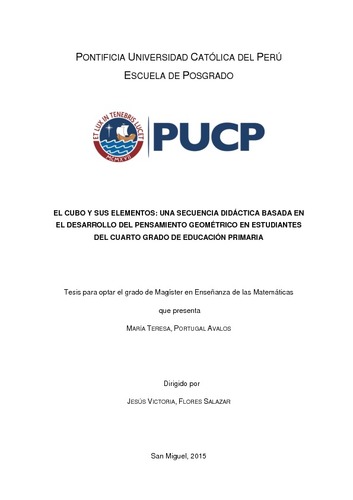| dc.contributor.advisor | Flores Salazar, Jesús Victoria | |
| dc.contributor.author | Portugal Ávalos, María Teresa | es_ES |
| dc.date.accessioned | 2016-04-25T15:03:59Z | es_ES |
| dc.date.available | 2016-04-25T15:03:59Z | es_ES |
| dc.date.created | 2015 | es_ES |
| dc.date.issued | 2016-04-25 | es_ES |
| dc.identifier.uri | http://hdl.handle.net/20.500.12404/6782 | |
| dc.description.abstract | El presente trabajo de investigación tiene como objetivo analizar, basados en la teoría de
Parzysz, el Desarrollo del Pensamiento Geométrico, específicamente el tránsito de las
etapas G0 a G1 en estudiantes del cuarto grado de educación primaria (9 y 10 años de
edad) cuando estudian la noción de cubo y sus elementos, por medio de una secuencia
didáctica en la que se usa el material concreto y el ambiente de geometría dinámica Cabri
3D, para lo cual planteamos la siguiente pregunta de investigación: ¿Estudiantes del 4to
grado de educación primaria desarrollan su Pensamiento Geométrico, en las etapas G0 y
G1, cuando estudian la noción de cubo y sus elementos en una secuencia didáctica con
material concreto y Cabri 3D?. Para este estudio tomamos como marco teórico el
Desarrollo del Pensamiento Geométrico de Parzysz y como marco metodológico aspectos
de la Ingeniería Didáctica de Artigue. La secuencia didáctica de la parte experimental
consta de dos actividades. La primera actividad tiene cuatro preguntas orientadas a
identificar el desarrollo del pensamiento geométrico en las etapas G0 y G1 en estudiantes
cuando estudian el cubo en material concreto. La segunda actividad consta también de
cuatro preguntas orientadas a distinguir la etapas G0 y G1 del Desarrollo del Pensamiento
Geométrico cuando estudian el cubo y sus elementos en las que se utiliza el Cabri 3D.
Finalmente, consideramos que el desarrollo de las dos actividades permitió identificar y
estudiar el tránsito de etapas G0 y G1 de los estudiantes al desarrollar la secuencia
didáctica. Además, pensamos que el uso del Cabri 3D en la segunda actividad fue
sustancial para el Desarrollo del Pensamiento Geométrico de los estudiantes ya que la
manipulación directa y el arrastre que este ambiente de geometría dinámica posee facilitó
dicho desarrollo. | es_ES |
| dc.description.abstract | This research aims to analyze, based on the theory of Parzysz, the development of
geometrical thinking, specifically the transit from G0 to G1 stage in fourth graders (9 to
10 years old) when they study the notion of cube and its elements, through a didactical
sequence in which the solid material and the environment of Cabri 3D dynamic geometry
were used. Thus, the following research question was raised: Did fourth-grade students
of primary education develop their geometrical thinking in the G0 and G1 stages while
studying the concept of cube and its elements in a didactical sequence with the solid
material and Cabri 3D?. For this study, we have considered the development of Parzysz´s
Geometrical Thinking as our theoretical framework, and some aspects of Artigue´s
Didactical Engineering as our methodological framework. The didactical sequence of the
experimental part consisted of two activities. The first activity had four questions
designed to identify the students’ development of geometrical thinking in the G0 and G1
stages in which they studied the particular solid cube. The second activity had also four
questions designed to distinguish the G0 and G1 geometrical thinking development stages
in which they studied the cube and its elements by using Cabri 3D. Finally, we
considered that the development of both activities allowed us to identify and study the
transit of the students from G0 to G1 stages while developing the didactical sequence
mentioned above. We also believed that the use of Cabri 3D in the second activity was
substantial for the development of students’ geometrical thinking due to the direct
manipulation and drag that this dynamic geometrical environment possesses which has
facilitated this development. | es_ES |
| dc.language.iso | spa | es_ES |
| dc.publisher | Pontificia Universidad Católica del Perú | es_ES |
| dc.rights | info:eu-repo/semantics/openAccess | es_ES |
| dc.rights.uri | http://creativecommons.org/licenses/by-nc-nd/2.5/pe/ | * |
| dc.subject | Matemáticas--Estudio y enseñanza (Primaria). | es_ES |
| dc.subject | Geometría--Estudio y enseñanza. | es_ES |
| dc.subject | Educación primaria--Investigaciones. | es_ES |
| dc.title | El cubo y sus elementos : una secuencia didáctica basada en el desarrollo del pensamiento geométrico en estudiantes del cuarto grado de educación primaria | es_ES |
| dc.type | info:eu-repo/semantics/masterThesis | es_ES |
| thesis.degree.name | Maestro en la enseñanza de las Matemáticas | es_ES |
| thesis.degree.level | Maestría | es_ES |
| thesis.degree.grantor | Pontificia Universidad Católica del Perú. Escuela de Posgrado | es_ES |
| thesis.degree.discipline | Enseñanza de las Matemáticas | es_ES |
| renati.discipline | 199117 | es_ES |
| renati.level | https://purl.org/pe-repo/renati/level#maestro | es_ES |
| renati.type | http://purl.org/pe-repo/renati/type#tesis | es_ES |
| dc.publisher.country | PE | es_ES |
| dc.subject.ocde | https://purl.org/pe-repo/ocde/ford#5.03.01 | es_ES |






